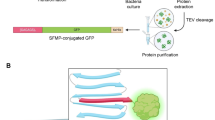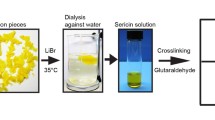Abstract
Silk fibroin is a widely used biocompatible medical material with tunable mechanical, degradability and environmental non-toxicity. This paper prepared the silk fibroin/chitosan hydrogel microneedle with pH sensitivity by blending silk fibroin with chitosan to induce graft cross-linking. The cross-linked silk fibroin/chitosan microneedles network is expanded by hydrogen ions and water molecules, forming a more significant swelling. In vitro, the transdermal drug release showed that insulin loaded in microneedles exhibited pH-sensitive drug release behavior and was released faster under acidic conditions than under neutral conditions. By changing the pH of the solution, microneedles can achieve a stimulating response to the environment, thereby intelligently regulating the transdermal release of insulin.










Similar content being viewed by others
Data availability
Not applicable.
References
Ogurtsova K, Da Rocha Fernandes JD, Huang Y et al (2017) IDF Diabetes atlas: global estimates for the prevalence of diabetes for 2015 and 2040. Diabetes Res Clin Pract 128:40–50. https://doi.org/10.1016/j.diabres.2017.03.024
Yaribeygi H, Atkin SL, Sahebkar A (2019) A review of the molecular mechanisms of hyperglycemia-induced free radical generation leading to oxidative stress. J Cell Physiol 234:1300–1312. https://doi.org/10.1002/jcp.27164
Galicia-Garcia U, Benito-Vicente A, Jebari S et al (2020) Pathophysiology of type 2 diabetes mellitus. IJMS 21:6275. https://doi.org/10.3390/ijms21176275
Yaribeygi H, Sathyapalan T, Atkin SL, Sahebkar A (2020) Molecular mechanisms linking oxidative stress and diabetes mellitus. Oxid Med Cell Longev 2020:1–13. https://doi.org/10.1155/2020/8609213
Chaudhury A, Duvoor C, Reddy Dendi VS et al (2017) Clinical review of antidiabetic drugs: implications for type 2 diabetes mellitus management. Front Endocrinol 8:6. https://doi.org/10.3389/fendo.2017.00006
Phan VHG, Mathiyalagan R, Nguyen MT et al (2022) Ionically cross-linked alginate-chitosan core-shell hydrogel beads for oral delivery of insulin. Int J Biol Macromol 222:262–271. https://doi.org/10.1016/j.ijbiomac.2022.09.165
Zhao J, Xu G, Yao X et al (2022) Microneedle-based insulin transdermal delivery system: current status and translation challenges. Drug Deliv and Transl Res 12:2403–2427. https://doi.org/10.1007/s13346-021-01077-3
Chen R, Weng J, Chow SF, Lakerveld R (2021) Integrated continuous crystallization and spray drying of insulin for pulmonary drug delivery. Cryst Growth Des 21:501–511. https://doi.org/10.1021/acs.cgd.0c01312
Bakh NA, Cortinas AB, Weiss MA et al (2017) Glucose-responsive insulin by molecular and physical design. Nature Chem 9:937–944. https://doi.org/10.1038/nchem.2857
Jin X, Zhu DD, Chen BZ et al (2018) Insulin delivery systems combined with microneedle technology. Adv Drug Deliv Rev 127:119–137. https://doi.org/10.1016/j.addr.2018.03.011
Sabbagh F, Muhamad II, Niazmand R et al (2022) Recent progress in polymeric non-invasive insulin delivery. Int J Biol Macromol 203:222–243. https://doi.org/10.1016/j.ijbiomac.2022.01.134
Cikrikci S, Mert B, Oztop MH (2018) Development of pH sensitive alginate/gum tragacanth based hydrogels for oral insulin delivery. J Agric Food Chem 66:11784–11796. https://doi.org/10.1021/acs.jafc.8b02525
Wang S, Zheng H, Zhou L et al (2020) Nanoenzyme-reinforced injectable hydrogel for healing diabetic wounds infected with multidrug resistant bacteria. Nano Lett 20:5149–5158. https://doi.org/10.1021/acs.nanolett.0c01371
Zheng L, Zhu D, Wang W et al (2022) A silk-microneedle patch to detect glucose in the interstitial fluid of skin or plant tissue. Sens Actuators, B Chem 372:132626. https://doi.org/10.1016/j.snb.2022.132626
Ulloa Rojas JE, Oliveira VLD, De Araujo DR et al (2022) Silk fibroin/poly(vinyl alcohol) microneedles as carriers for the delivery of singlet oxygen photosensitizers. ACS Biomater Sci Eng 8:128–139. https://doi.org/10.1021/acsbiomaterials.1c00913
Jung JH, Jin SG (2021) Microneedle for transdermal drug delivery: current trends and fabrication. J Pharm Investig 51:503–517. https://doi.org/10.1007/s40005-021-00512-4
Yu J, Wang J, Zhang Y et al (2020) Glucose-responsive insulin patch for the regulation of blood glucose in mice and minipigs. Nat Biomed Eng 4:499–506. https://doi.org/10.1038/s41551-019-0508-y
Chen BZ, Zhang LQ, Xia YY et al (2020) A basal-bolus insulin regimen integrated microneedle patch for intraday postprandial glucose control. Sci Adv 6:eaba7260. https://doi.org/10.1126/sciadv.aba7260
Turner JG, White LR, Estrela P et al (2021) Hydrogel-forming microneedles: current advancements and future trends. Macromol Biosci 21:2000307. https://doi.org/10.1002/mabi.202000307
Farokhi M, Mottaghitalab F, Samani S et al (2018) Silk fibroin/hydroxyapatite composites for bone tissue engineering. Biotechnol Adv 36:68–91. https://doi.org/10.1016/j.biotechadv.2017.10.001
Nguyen TP, Nguyen QV, Nguyen VH et al (2019) Silk fibroin-based biomaterials for biomedical applications: a review. Polymers 11:1933. https://doi.org/10.3390/polym11121933
Ways M, Lau W, Khutoryanskiy V (2018) Chitosan and its derivatives for application in mucoadhesive drug delivery systems. Polymers 10:267. https://doi.org/10.3390/polym10030267
Li J, Zhuang S (2020) Antibacterial activity of chitosan and its derivatives and their interaction mechanism with bacteria: current state and perspectives. Eur Polymer J 138:109984. https://doi.org/10.1016/j.eurpolymj.2020.109984
Negm NA, Hefni HHH, Abd-Elaal AAA et al (2020) Advancement on modification of chitosan biopolymer and its potential applications. Int J Biol Macromol 152:681–702. https://doi.org/10.1016/j.ijbiomac.2020.02.196
Patrulea V, Ostafe V, Borchard G et al (2015) Chitosan as a starting material for wound healing applications. Eur J Pharm Biopharm 97:417–426. https://doi.org/10.1016/j.ejpb.2015.08.004
Wang W, Meng Q, Li Q et al (2020) Chitosan derivatives and their application in biomedicine. IJMS 21:487. https://doi.org/10.3390/ijms21020487
Sahariah P, Másson M (2017) Antimicrobial chitosan and chitosan derivatives: a review of the structure-activity relationship. Biomacromol 18:3846–3868. https://doi.org/10.1021/acs.biomac.7b01058
Verlee A, Mincke S, Stevens CV (2017) Recent developments in antibacterial and antifungal chitosan and its derivatives. Carbohyd Polym 164:268–283. https://doi.org/10.1016/j.carbpol.2017.02.001
Tuwalska A, Grabska-Zielińska S, Sionkowska A (2022) Chitosan/silk fibroin materials for biomedical applications—a review. Polymers 14:1343. https://doi.org/10.3390/polym14071343
Xu Z, Chen T, Zhang K et al (2021) Silk fibroin/chitosan hydrogel with antibacterial, hemostatic and sustained drug-release activities. Polym Int 70:1741–1751. https://doi.org/10.1002/pi.6275
Zhu M, Liu Y, Jiang F et al (2020) Combined silk fibroin microneedles for insulin delivery. ACS Biomater Sci Eng 6:3422–3429. https://doi.org/10.1021/acsbiomaterials.0c00273
Wang S, Zhu M, Zhao L et al (2019) Insulin-loaded silk fibroin microneedles as sustained release system. ACS Biomater Sci Eng 5:1887–1894. https://doi.org/10.1021/acsbiomaterials.9b00229
Cao J, Liu Y, Qi Z et al (2022) Sustained release of insulin from silk microneedles. J Drug Deliv Sci Technol 74:103611. https://doi.org/10.1016/j.jddst.2022.103611
Yin Z, Kuang D, Wang S et al (2018) Swellable silk fibroin microneedles for transdermal drug delivery. Int J Biol Macromol 106:48–56. https://doi.org/10.1016/j.ijbiomac.2017.07.178
Tao X, Jiang F, Cheng K et al (2021) Synthesis of pH and glucose responsive silk fibroin hydrogels. IJMS 22:7107. https://doi.org/10.3390/ijms22137107
Chen S, Matsumoto H, Moro-oka Y et al (2019) Smart Microneedle fabricated with silk fibroin combined semi-interpenetrating network hydrogel for glucose-responsive insulin delivery. ACS Biomater Sci Eng 5:5781–5789. https://doi.org/10.1021/acsbiomaterials.9b00532
Chen S, Matsumoto H, Moro-oka Y et al (2019) Microneedle-array patch fabricated with enzyme-free polymeric components capable of on-demand insulin delivery. Adv Funct Mater 29:1807369. https://doi.org/10.1002/adfm.201807369
Shah D, Guo Y, Ocando J, Shao J (2019) FITC labeling of human insulin and transport of FITC-insulin conjugates through MDCK cell monolayer. J Pharm Analy 9:400–405. https://doi.org/10.1016/j.jpha.2019.08.002
Cammarata CR, Hughes ME, Ofner CM (2015) Carbodiimide induced cross-linking, ligand addition, and degradation in gelatin. Mol Pharm 12:783–793. https://doi.org/10.1021/mp5006118
Sow LC, Nicole Chong JM, Liao QX et al (2018) Effects of κ-carrageenan on the structure and rheological properties of fish gelatin. J Food Eng 239:92–103. https://doi.org/10.1016/j.jfoodeng.2018.05.035
Xu Z, Tang E, Zhao H (2019) An environmentally sensitive silk fibroin/chitosan hydrogel and its drug release behaviors. Polymers 11:1980. https://doi.org/10.3390/polym11121980
Ke CL, Deng FS, Chuang CY et al (2021) Antimicrobial actions and applications of chitosan. Polymers 13:904. https://doi.org/10.3390/polym13060904
Yu D, Feng J, You H et al (2022) The microstructure, antibacterial and antitumor activities of chitosan oligosaccharides and derivatives. Mar Drugs 20:69. https://doi.org/10.3390/md20010069
Chen X, Yu H, Wang L et al (2021) Cross-linking-density-changeable microneedle patch prepared from a glucose-responsive hydrogel for insulin delivery. ACS Biomater Sci Eng 7:4870–4882. https://doi.org/10.1021/acsbiomaterials.1c01073
Zong Q, Zhou R, Zhao Z et al (2022) Glucose-responsive insulin microneedle patch based on phenylboronic acid for 1 diabetes treatment. Eur Polymer J 173:111217. https://doi.org/10.1016/j.eurpolymj.2022.111217
Tong Z, Zhou J, Zhong J et al (2018) Glucose- and H2O2 -responsive polymeric vesicles integrated with microneedle patches for glucose-sensitive transcutaneous delivery of insulin in diabetic rats. ACS Appl Mater Interfaces 10:20014–20024. https://doi.org/10.1021/acsami.8b04484
Zhang H, Gu Z, Li W et al (2022) pH-sensitive O-carboxymethyl chitosan/sodium alginate nanohydrogel for enhanced oral delivery of insulin. Int J Biol Macromol 223:433–445. https://doi.org/10.1016/j.ijbiomac.2022.10.274
Mallawarachchi S, Mahadevan A, Gejji V, Fernando S (2019) Mechanics of controlled release of insulin entrapped in polyacrylic acid gels via variable electrical stimuli. Drug Deliv Transl Res 9:783–794. https://doi.org/10.1007/s13346-019-00620-7
Acknowledgements
National Natural Science Foundation of China (Grant No. 51973144), Natural Science Research of Jiangsu Higher Education Institutions of China (Grant No. 20KJA540002), PAPD and Six Talent Peaks Project in Jiangsu Province (Grant No. SWYY-038) supported this work.
Author information
Authors and Affiliations
Contributions
JT wrote the paper; KD conceived and designed the experiments; QZ and TG performed the experiments; YX analyzed the data; JT contributed reagents/materials/analysis tools; KSC and LS conducted writing and review. All authors have read and agreed to the published version of the manuscript.
Corresponding author
Ethics declarations
Conflict of interest
The authors declare no competing financial interest.
Ethical approval
Not Applicable.
Additional information
Handling Editor: Stephen Eichhorn.
Publisher's Note
Springer Nature remains neutral with regard to jurisdictional claims in published maps and institutional affiliations.
Rights and permissions
Springer Nature or its licensor (e.g. a society or other partner) holds exclusive rights to this article under a publishing agreement with the author(s) or other rightsholder(s); author self-archiving of the accepted manuscript version of this article is solely governed by the terms of such publishing agreement and applicable law.
About this article
Cite this article
Jia, T., Kuang, D., Qi, Z. et al. Silk fibroin/chitosan pH-sensitive controlled microneedles. J Mater Sci 58, 17711–17725 (2023). https://doi.org/10.1007/s10853-023-09148-1
Received:
Accepted:
Published:
Issue Date:
DOI: https://doi.org/10.1007/s10853-023-09148-1




